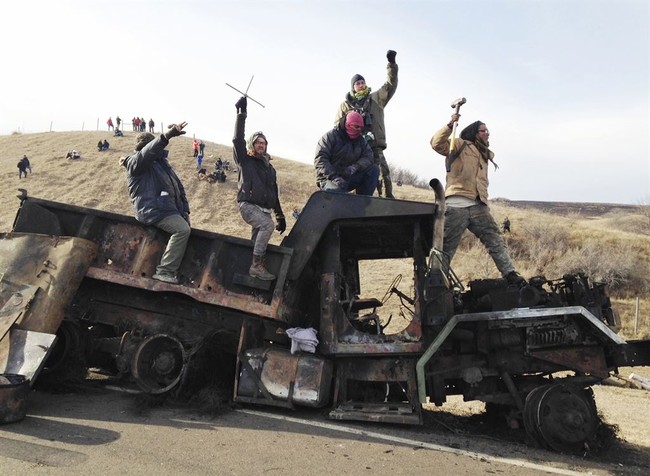
In March, Greenpeace lost a trial in North Dakota and a jury determined they should pay Energy Transfer, the company that built the Dakota Access Pipeline, a total of $667 million in damages. Greenpeace said at the time that even half that amount could potentially bankrupt them.
Last week, Greenpeace asked a judge to reduce the amount of the damages and also to stay the verdict while they appeal.
Greenpeace wants a North Dakota judge to reduce the nearly $667 million in damages it was ordered to pay the developer of the Dakota Access Pipeline in March, arguing that the award is excessive and unreasonable…
Greenpeace denies Energy Transfer’s allegations and says the company only brought the lawsuit to chill environmental activism. The defendants have yet to appeal.
In the meantime, attorneys for Greenpeace have asked Southwest Judicial District Judge James Gion to slash the nearly $667 million award, claiming it exceeds statutory caps on damages and that the verdict is riddled with inconsistencies.
“This is the poster child of where the court needs to step in,” Steven Caplow, an attorney representing Greenpeace, said in a Thursday morning remote hearing.
Energy Transfer says Gion should let the jury’s award stand. Trey Cox, an attorney representing the pipeline developer, called the damages “consistent with the evidence produced at trial and the law of the state of North Dakota.”
Greenpeace made a separate motion asking the judge to simply toss out the entire verdict. Another hearing is scheduled for next Tuesday so we may get a ruling on some of these motions by then.
Greenpeace has been framing this entire case as one about free speech even months before the verdict. Here’s a video they put together last August.
The counter-argument, which was made at trial, is that Greenpeace went well beyond protected speech into defamation and support for “direct action” against the company which delayed the project and cost Energy Transfer millions of dollars. Commentary published an excellent piece on this last week.
The pipeline eventually got finished, but Energy Transfer CEO Kelcy Warren wasn’t satisfied. “What they did to us is wrong,” Warren said in a 2017 interview, “and they’re gonna pay for it.” The company’s suit charged Greenpeace USA (and other branches of the global NGO) with civil conspiracy and trespass for the role it alleged they played in funding and directing extremist factions in the protest. Energy Transfer also asserted the NGO defamed the company through dishonest accusations and disrupted its relations with financial backers. Greenpeace argued its actions were protected under the First Amendment. The Mandan, North Dakota, jury sided with the plaintiff on almost all points.
Energy Transfer no doubt faces years of appeals before it can collect any of the staggering $667 million judgment. But the company’s lawsuit has already exposed some of the shady linkages between liberal NGOs and violent anarchists. Evidence produced in court showed that Greenpeace raised $20,000 to send trainers (including a Greenpeace employee) to teach what it called “non-violent direct action skills” to the protesters. The charity also donated a solar-panel-equipped van, power tools, propane tanks, and other gear. Greenpeace USA then–executive director, Annie Leonard, was all-in on the effort. “We have provided massive support for this cause since day one in terms of people, material, support and funding,” she wrote in a 2016 email. Leonard also used her Greenpeace email account to personally raise another $90,000 to support the protests.
One Greenpeace trainer bragged in an email about doing “some awesome spy shit” as he scouted locations where activists could blockade construction equipment. Another was photographed using a “lockbox” to chain himself to a piece of heavy equipment. A lockbox is a heavy plastic or concrete tube into which two or more protesters can lock their arms, forming a human chain and forcing police to spend hours carefully cutting through it. It is a favorite tactic used by climate protesters who think blocking highways during rush hour will save the planet. Greenpeace sent at least 20 of the lockbox devices to Standing Rock.
At the trial, Greenpeace argued that local tribal leaders led the protests and that the nonprofit offered only indirect support. According to the AP, Energy Transfer’s lawyer said the nonprofit “exploited a small, disorganized, local issue to promote its agenda,” and described the group as “master manipulators.” It’s possible Greenpeace was just one of several outside groups backing the most militant factions at Standing Rock. But first-hand accounts from the months-long protests do suggest the Sioux elders urging nonviolence gradually lost control to outside agitators. On an anarchist website, one young radical recounts how advocates for peaceful protest were overruled by the militant faction blocking a road near the pipeline. With undisguised joy he describes the subsequent all-night battle with police: “Rocks and Molotov cocktails defend the barricade; a wall of plywood shields deflects rubber bullets and tear gas cannisters. The partisans of nonviolence are gone.”
Frankly, I’d be fine with the judge cutting the judgment in half and then forcing Greenpeace to pay the remaining amount immediately. But I guess the more realistic outcome is that Greenpeace will get a stay and then drag out the appeal for at least another year or longer. They have other legal problems in countries around the world so they can’t afford this to come to a resolution anytime soon.
The captain of Greenpeace’s vessel Rainbow Warrior and four activists made their first appearance in a South Korean court on Friday, May 16, on charges related to a 2024 incident where they boarded a Japanese-owned LPG tanker that was anchored off South Korea. They have been detained in the country since November after the protest in which they used the ship to call for a strong international plastics treaty ban…
Greenpeace contends it was a peaceful protest and put no one in danger. They said the tanker was waiting to load chemicals at the Hyundai Daesan Refinery.
The South Korean police took the four into custody along with the captain of the Rainbow Warrior and held them for nearly two days during the investigation. While they were released, they were ordered to remain in South Korea for the outcome of the investigation.
Greenpeace is right about one thing. This is a very important case and, hopefully, a model for taking on other left-wing groups that organize illegal activity on behalf of their cause.












